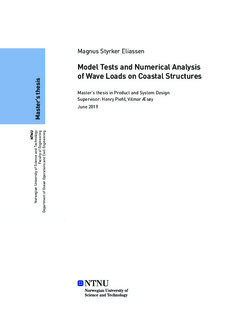| dc.contributor.advisor | Piehl, Henry | |
| dc.contributor.advisor | Æsøy, Vilmar | |
| dc.contributor.author | Eliassen, Magnus Styrker | |
| dc.date.accessioned | 2019-10-03T14:00:23Z | |
| dc.date.available | 2019-10-03T14:00:23Z | |
| dc.date.issued | 2019 | |
| dc.identifier.uri | http://hdl.handle.net/11250/2620145 | |
| dc.description.abstract | Denne forskningen er basert på å utforske effekten fra bølgekraft på kystnære strukturer. Et alternativ til dagens skiftende søkelys på renere og mer fornybar energi, er vindmøller plassert til sjøs. Mer spesifikt, er det den sylindriske strukturen som vindmøllene er plassert på som er fokus for oppgaven. Forskningen sikter på å finne ut hvilke metoder som er best egnet for å utvikle en numerisk test tank og hvordan den kan bli brukt til simulerings-basert design av strukturer i bølger.
For å utforske effekten fra bølgekraft på kystnære strukturer, blir både numeriske- og eksperimentelle metoder brukt. Disse metodene ble brukt til å etterligne et scenario hvor bølger blir skylt på en sylindrisk struktur. Den sylindriske strukturen blir utviklet virtuelt og analysert. Vurdering av sensorer brukt til de eksperimentelle testene ble gjort for å forsikre resultatene. Ettersom det ble brukt flere metoder for å oppnå resultater, er parameterne så identiske som mulig. Dette begrenser forskningen til mulighetene og størrelsen ved bølgetanken som skal brukes i de eksperimentelle testene. De numeriske modellene er basert på computational fluid dynamics og computer aided engineering.
Resultatene fra forskningen viser at med de gitte parameterne, er den påførte bølgekraften på den sylindriske strukturen relativt lave. Både de numeriske- og eksperimentelle metodene viser at resultatene havner i samme område. Dette viser at forskningen har potensiale. | |
| dc.description.abstract | This research investigates the effects of wave loads on coastal structures. With today's shifting focus towards clean and renewable energy, sources such as offshore wind turbines offer a promising potential. More specifically, the research is focusing on the cylindrical structure which the wind turbines are based on. The research aims to investigate what methods are most suited to develop a numerical test tank and how it can be used for simulation-based design of structures in waves.
To investigate the effect of wave loads on coastal structures, both numerical- and experimental methods were used. These methods were used to replicate a scenario where waves are washed against a cylindrical structure. The cylindrical structure is virtually developed and analyzed. Assessment of sensor performance for the experimental tests was done to ensure the credibility of the research. Since it is used multiple methods to obtain results, the parameters are as identical as possible. This limits the research to the capabilities and dimensions of the wave tank available for the scaled experimental tests. The numerical models are based on computational fluid dynamics and computer aided engineering.
The results from the research show that with the given parameters, the exerted wave force on a cylindrical structure is quite low. Both the numerical- and experimental models provide results that are in the same range. By getting similar results for different methods, the research shows that it has potential. | |
| dc.language | eng | |
| dc.publisher | NTNU | |
| dc.title | Model Tests and Numerical Analysis of Wave Loads on Coastal Structures | |
| dc.type | Master thesis | |
